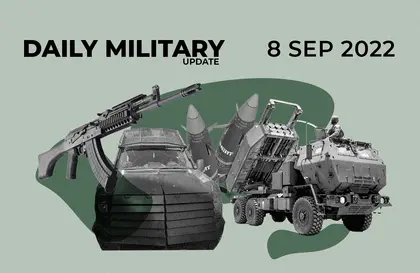Ukraine’s Armed Forces (UAF) on Thursday, Sept. 8, were expanding Kyiv’s most ambitious offensive to date, with UAF armored columns advancing as much as 40 kilometers in the Kharkiv sector, and widespread reports of serious Russian losses in men and equipment across the fighting line.
Ukrainian military spokespersons on Thursday confirmed a major attack operation was in progress and appealed to civilians and service personnel not to make public details about the scale and direction of the attacks.
JOIN US ON TELEGRAM
Follow our coverage of the war on the @Kyivpost_official.
Nonetheless, Ukrainian military-associated social media and independent news agencies flooded the Internet with images of Ukrainian troops advancing, destroyed and captured RF military equipment, and dozens of RF prisoners of war. RF-associated media mostly matched that picture, describing a large-scale UAF offensive which RF troops were, so far, struggling to contain. Two UAF members serving with the front line in Kharkiv sector at separate locations confirmed to Kyiv Post by phone message that their units were on the attack, and at times patrolling behind RF front lines.
The Washington-based think tank Institute for the Study of War (ISW) released a situation update on the evening of Wednesday, Sept.7, stating that a substantial UAF offensive operation was in progress. By the morning of Thursday, Sep. 8, UAF troops had, per multiple reports from both Ukraine- and Russia-associated sources, bypassed Balakliya, advanced more than 20 kilometers to the north-east, and had taken control of the villages of Verbivka and Volokhiv Yar, deep behind RF front lines.

British Defence Intelligence Update Ukraine 23 January 2025
Portions of two Russian units originally defending the town – reportedly a pair of special forces police units from Baskhiriya and Samara – were per RF media reports isolated in the center of Balakiya, cut off from communication with headquarters, but still holding out.
One unconfirmed RF report said reinforcements had broken through to the surrounded policemen. The Kremlin narrative of a die-hard RF defense of Balakliya by tough Russian police against heavy odds was contradicted by images and videos posted by UAF troops, which showed more than 40 Russian POWs captured in Balakliya and elsewhere in Kharkiv sector. Some RF prisoners were shown to be members of the Samara special police. All sources reported that fighting in the town was still in progress.
According to a situation estimate released by Ukraine’s Army General Staff (AGS) on the morning of Thursday, Sep. 8, RF forces over the past 24 hours had suffered heavy losses on Wednesday, including 15 tanks, 37 armored personnel carriers, 32 artillery systems and five rocket artillery systems. Wednesday’s RF equipment casualties tallied by the Netherlands-based Oryx analytical team largely matched the Ukrainian army estimate, with the independent research group counting, among other confirmed RF losses for the day, 12 tanks and 31 armored personnel carriers.
The RF-affiliated RuTube military channel Podribniy stated in a situation update on Thursday, Sep. 8, that Kyiv has concentrated at least 200 artillery pieces and rocket artillery systems – practically all NATO-standard firing precision-guided munitions – in the Kharkiv sector. RF losses to these advanced weapons have been serious, the report added.
The backbone of the UAF ground assault is three or four armored brigades, a force theoretically numbering more than 10,000 men, that had recently completed training in Great Britain, had been beefed up with 200 T-72 tanks donated by Poland, and was now committed to the Kharkiv offensive, Podribniy said, without providing evidence. The location and strength of UAF reserve forces is a closely-guarded Ukrainian military secret.
Yuriy Butusov, a leading Ukrainian military correspondent, in a Facebook post on the morning of Thursday, Sep. 8, pointed to a separate, parallel, and even more successful UAF thrust developing to the north of Balakliya. This force reportedly bypassed the town completely and, meeting little resistance, advanced all the way to the town of Shevchenko, some 30 km from the attack’s start point by direct line, and close to 50 km by road. This was by far the deepest penetration into organized RF defenses managed by UAF ground forces since the war began.
According to Butusov, Shevchenko is the central, medium-term objective of the UAF offensive in the Kharkiv sector. Multiple RF sources confirmed UAF control of the town, a nexus of RF military logistics for the entire region, which could place RF forces stretching more than 200 kilometers from Izium to the RF border, in jeopardy.
Social media posts by jubilant UAF soldiers celebrating battlefield success – strict orders from army top command forbidding it notwithstanding – poured into the public domain. Possibly iconic, and in any case heavily forwarded content included a dejected Russian lieutenant colonel made a prisoner of war, UAF troops ripping down a Russian flag in Balakliya, RF fighting positions littered with trash and RF soldier corpses, and residents of the village of Verbivka waving at advancing UAF armored infantry.
Some RF social media claimed that UAF troops were advancing under heavy anti-aircraft protection, a tactic that is keeping the RF air force at a distance. Other RF social media, more upset with the UAF attacks, accused the RF senior commander in the sector, Lieutenant General Andrei Sychoviy, of incompetence and RF air force pilots of cowardice.
You can also highlight the text and press Ctrl + Enter










